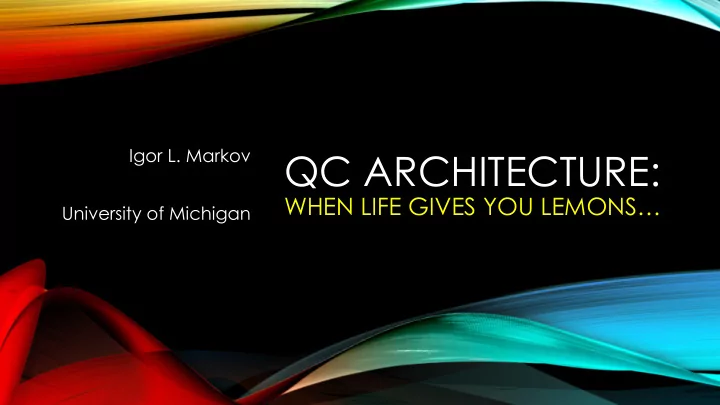

Igor L. Markov QC ARCHITECTURE: WHEN LIFE GIVES YOU LEMONS… University of Michigan
LEMONS à LEMONADE Traditional digital systems Qubit systems • Huge numbers of fast gates and wires • Very few, flaky gates; so-so interconnect of exceptional quality • No memory modules to speak of • A deep memory hierarchy (cheap ECC) • Quantum no-cloning theorem • Data are routinely copied, e.g., cached • Non-deterministic errors in gates, I/O • An illusion of digital determinism • No error masking by gates • CMOS xtors pull up to 1 or pull down to 0 • Nonstationary error distributions • Analog delays masked by FFs & clocking • Tricky correlations • Design guard-bands for crosstalk, etc • QECC is too expensive for near-term QC • Careful yield management • Slow I/O, sometimes pathologically so • High-perf I/O, large amounts of data • Extreme cooling • Verification, test, full-system simulation • Cannot be fully simulated on existing sys • Programming, power-density, security • Promise to solve some comp tasks quickly
QUANTUM COMPUTATION: THE FINEPRINT • No new decision powers • No NP-complete problems in poly time • No asymptotic speed-up for sorting • Hence, no universal speed-up • No speedup from single-q gates expected • Main promise is in accelerators (with some programmability) • Surprisingly few good applications • Surprisingly difficult to build hardware
LOOKING FOR AN END-TO-END SPEEDUP OVER HIGHLY OPTIMIZED CLASSICAL SYSTEMS Time is many things, but he is not money. – Alice
CRITERIA FOR SUCCESS: “QUANTUM SUPREMACY” STYLE • A concrete application • No vagueness (“variants of this problem find uses in…”) • Useful or made-up? • Problem instances clearly described + benchmarks • OK to revise later, OK to post-select on easiness for QC • Best classical methods identified, improved if needed • Don’t repeat the D-Wave QUBO fiasco • Compelling speedup over best classical methods • CPUs? GPUs? FPGAs? Supercomputers? • ASICs? Dilution refrigerators? • Objectives and constraints other than time • Power dissipation, cost, form factor
QUANTUM ARCHITECTURE TRADEOFFS
KEY DESIGN ISSUES • Quantum speedup: exp? sqrt? • Environment: cooling, etc • Data and I/O • Error rates and distros • Quantum resources needed: • Validation, BIST/feedback • Qubits, gates, circuit depth • Classical control HW • Qubits: Superconductors? Ions? • Room for optimization? • Hard-to-simulate gates • Software toolchain? • Locality • Compilers • Circuit optimizers • Quantum overheads, such as • Simulators & validation • Slow quantum gates, arith circuits • SW control • QECC and classical control
• 72 qubits, runs Google QS circuits • Although no one has achieved this goal yet, we calculate quantum supremacy can be comfortably demonstrated with 49 qubits, a circuit depth exceeding 40 , and a two-qubit error below 0.5% • (1 – 0.005) 420 ~ 0.12 • Also, measurement and qubit-init errors • Folklore: circuit fidelity target 0.005
HISTORICAL EXAMPLES Both systems are operational • Anton 1 and 2 used in many scientific studies / papers • Commercial success unclear
QUESTIONS?
Recommend
More recommend